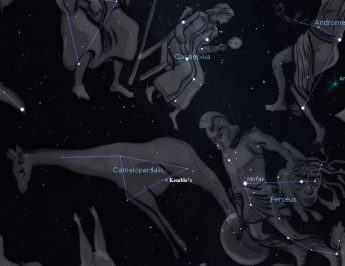This Week’s Sky at a Glance, 2025 Oct 11 – Oct 18
This Week’s Sky at a Glance, 2025 Oct 11 – Oct 18
Being between moose and deer seasons, and with the full Moon out of the way, this weekend might be a good time for some good old-fashioned giraffe hunting. No guns allowed, just find a place where the sky is not tainted by light pollution and bring binoculars for an added treat.
The large constellation Camelopardalis is somewhat easier to pronounce than it is to locate in the sky. Look below Cassiopeia and between Perseus and Ursa Minor (the Little Dipper, which has the North Star at the end of the handle). Any stars you can see in this area compose the not-so-stellar giraffe. The constellation was imagined and charted on a globe by Dutch astronomer Petrus Plancius in 1612 and later adopted by other prominent makers of star charts. The name derives from how the Greeks regarded giraffes as camel leopards, with their long neck and spots.
An interesting binocular object called Kemble’s Cascade is an observing highlight within Camelopardalis. This asterism, forming a line of about 20 stars, was noticed by Canadian amateur astronomer Father Lucien Kemble, who reported it to a columnist at Sky and Telescope magazine. One method of finding your way there is to imagine a line across the top stars of Cassiopeia’s W shape, right to left, and extend it an equal distance. Another is to extend an equal length line from Algol to Mirfak, the two brightest stars in Perseus. Near one end of this asterism a telescope will reveal the open star cluster NGC 1502, which is nicknamed the Jolly Roger Cluster.
This Week in the Solar System
Saturday’s sunrise in Moncton is at 7:31 and sunset will occur at 6:39, giving 11 hours, 8 minutes of daylight (7:35 and 6:45 in Saint John). Next Saturday the Sun will rise at 7:40 and set at 6:27, giving 10 hours, 47 minutes of daylight (7:44 and 6:33 in Saint John).
The third quarter Moon rises near Jupiter around midnight Monday evening. Saturn is at its highest and best for observing in late evening. Mars will be half a binocular field above Mercury in evening twilight next Friday, a challenging target. Around 6 am Venus will be making its presence known low in the eastern sky. Late in the week we might start seeing some early streakers from the Orionid meteor shower, which peaks on October 21.
The William Brydone Jack Astronomy Club meets in the UNB Forestry-Earth Sciences building on Tuesday at 7 pm. Tune in to the Sunday Night Astronomy Show at 8 pm on the YouTube channel and Facebook page of Astronomy by the Bay.

